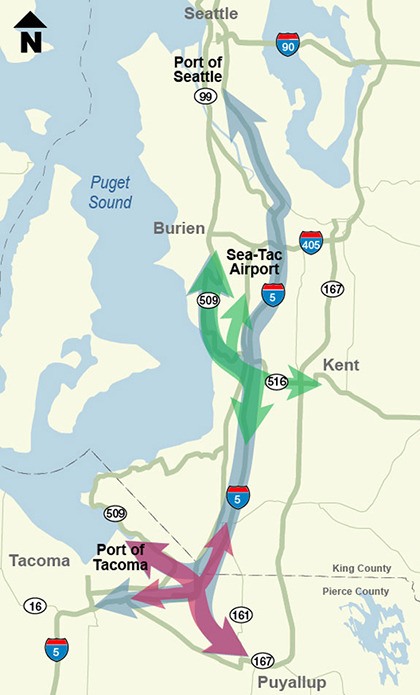Engineers began planning the first phases of State Routes 167 and 509 in the 1950s, and road crews built them in the 1960s — but from the start, the intention was that someday these corridors would connect to I-5.
Someday is now, John White, director of tolled corridor development for the Washington State Department of Transportation, told members of the Auburn City Council at City Hall on Monday as he laid out the guts of WSDOT’s latest mega construction proposal, the Puget Sound Gateway Project.
“The heart of the story is structured around finishing what you started,” White said. “There’s also freight mobility and local, regional and statewide economies in the story. … These corridors were not completed, and the result is that people who should have been using them to get more efficiently to their destinations can’t, so they divert to their local arterials, they divert to I-5. So, other roadways have taken on an extra burden by 167 and 509 not being complete.
“This helps bring people back to those corridors where they were intended to be,” White added.
The point is to relieve traffic congestion and complete critical freight links between the Ports of Tacoma and Seattle and key distribution centers and warehouses in both counties. White said that doing so would support regional job and economic growth at the two ports and add 10-to-20 percent more capacity to I-5 through express toll lanes, thereby reducing congestion and travel times between Seattle and Tacoma.
And the project would support master land use plans and economic development plans of cities along the Gateway corridors.
The state’s plan calls for the 167 and 507 corridor projects to be bundled financially with proposed I-5 express toll lanes. Everything would be built at the same time, to create, White said, more of “a holistic, fair and equitable approach.”
Cost estimates for Phase 1
Plans show that the total cost estimate for the first phase of the Gateway project is $1.73 billion, divided as follows: $824 million for 167; $758 million for 509; and $140 million for the I-5 express lanes. The State House in 2013 passed a bill that adopted this plan, but the State Senate did not follow up.
The DOT is proposing to fund the project with $330 million in potential toll revenue and $130 million in stakeholder partnerships. Given the $1.1 to $1.5 billion funding gap, the DOT will rely on new state revenue from the Legislature either in a special 2013 session, or in regular session in 2014. It will also apply to federal grant programs, but largest source of state funding would be the gas tax.
“We’re looking to the Legislature and the governor’s office to hopefully take action,” White said, adding that, should all the funding be in place by 2014, and updates completed on the environmental impact statements (EIS) for both corridors, and designs updated, and all right-of-way acquired, construction could begin by 2017. And under that optimistic scenario, the work could be finished by 2021.
“We just don’t want to count on it right now,” White cautioned about that timeline. “Right now we have something of a play-it-safe schedule.”
Here is a summary of the work described by the Puget Sound Gateway Project.
State Route 167
Extension of 167 from SR 161, where it now ends, and connecting the highway to 509 west of I-5, as follows:
• A new lane in each direction between 161 at Meridian Street in Puyallup and Valley Avenue in Sumner, and a second lane in each direction between Valley Avenue and 54th Avenue East
• Replacement of the Porter Way overpass
• Completion of the interchange at 161
• Replacement of 70th Avenue East from 20th Street East to SR 99
• New interchanges: 167 at I-5; to and from east at 54th Avenue East; to and from west at Valley Avenue; and to and from east at Freeman Road
State Route 509
Extension of 509, which starts at the First Avenue South bridge in South Seattle and ends at South 188th Street, parallel to Sea-Tac Airport, as follows:
• Adding one new lane in each direction between South 188th Street and 28th/24th Avenues south
• Adding a second lane in each direction between I-5 and 28th/24th Avenues south
• Adding truck climbing lanes in each direction, as needed, where the grades are steep
• Completion of the interchange at South 188th Street and 509
• Replacement of the interchange at SR 516 to include new I-5 collector distributor connections
• A new southbound I-5 lane between 516 and South 272nd Street
• New interchanges: at 509 and I-5; to and from east at 28th and 24th Avenue South; and to South 231st Way and the Auburn Valley.
As to phasing of the corridor projects, White said, “Everything is built around tolling.”
“The presumption for 167 and 509 is that both corridors would have all [HOV] lanes tolled – what we call variable tolling – the same story as for 520. During a peak period, you would pay more of a premium toll, when time is money and your commute trip is valuable, and there’s a lot of demand out there. During the off-peak periods there would be a very modest toll,” White said.
I-5 Express toll lanes
• Phase 1, conversion of the existing I-5 HOV lane to an express toll lane between I-90 and SR 16. In Phase 2 the state would add a second express toll lane between 509 and 167 and direct connections at the 509 and 167 interchanges.
“Would the toll eventually go away?” Councilwoman Largo Wales asked.
“I can’t give a definitive answer to that,” White said, noting that the Legislature “holds all the cards.”
Wales also criticized the plan for not asking enough from the business community.


